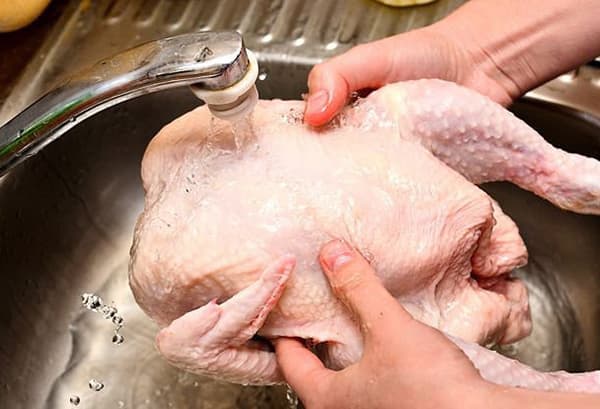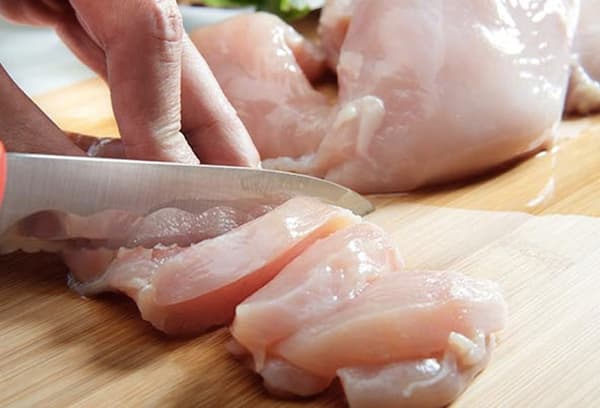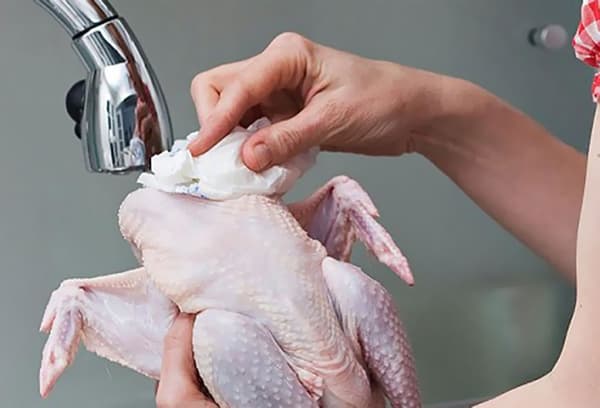Is chicken washed before cooking?
Since childhood, our parents taught us to be sure to wash food before eating it. As a rule, this concerned fruits, vegetables, nuts or dried fruits. When we, already as adults, began to comprehend the basics of home cooking, then experienced, connoisseurs or the same parents, wise from experience, certainly instructed: it is necessary to wash the chicken! However, if with the same apples or tomatoes everything is clear and logical, then the “meat theme” is far from so clear...

Debunking myths
It would seem that washing a store-bought chicken carcass before cutting it up for frying or soup - what could be more logical? After all, it is unknown how, where and under what conditions it was stored before it appeared in our grocery basket. But, according to food technology scientists, washing chicken before cooking is strictly prohibited!
The point is not any deterioration in taste, but the fact that when washing the bird under water, pathogenic bacteria are washed away from the surface of the meat and its entrails. Whether you use running or standing water, salmonella, capylobacter and other dangerous bacteria will easily spread throughout the sink, sink, surrounding walls and your skin. This process is called aerolization.
Don’t think that as the liquid dries, the bacteria will also die. A different, less pleasant outcome is more likely, when the same salmonella “migrates” to other kitchen surfaces and cutlery.
Of course, raw chicken comes into contact with many surfaces outside the sink - with the cutting board, the blade of the knife and the cook’s hands. Since the meat is going to come into contact with so many objects, isn’t it better to wash it first to reduce the risk of infection?
It is worth understanding one important thing: contact with surfaces is controlled by the cook, and these surfaces will subsequently be thoroughly washed using cleaning and antibacterial agents, but a stream of water that hits the bird carcass will scatter over the sink, walls, and clothes of the cook with millions of microdroplets, in which already the infection will live. The “damage zone” is no less in the case of standing water. After such a “shower” for one small chicken, do you really want to do a thorough cleaning in the kitchen and wash your own clothes?
It's not just chicken that's at risk
This rule of spreading bacteria from the surface of meat through water does not only apply to chicken.
Pathogenic microorganisms also multiply on other types of meat:
- pork,
- beef,
- lamb,
- all other types of poultry.
Even if you purchased, for example, vacuum-packed fillets, this does not at all guarantee that during the preparation of such a product, bacteria have not begun to spread on it.
Thus, the approach to preparation will be the same regardless of what kind of product you are going to cook and what you are going to do with it: you cannot wash meat before boiling, frying, baking or cutting for freezing!
How to be?
A reasonable question: how to prepare such an important ingredient for further work if it cannot be treated with water, and the surface is infested with infection? What if it’s just plain dirty?
You can immediately give an equally reasonable answer to the second question: you don’t need to purchase such a product! If you see that the carcass has a completely unpresentable, dirty appearance and does not smell well, then you are unlikely to prepare a delicacy from it, and even heat treatment will not save you from digestive problems or even more serious problems.
The answer to the first question is also simple. Use available products to clean and prepare meat:
- disposable wipes;
- paper towels;
- any other clean, disposable cloth.
In addition, modern stores offer customers goods that are quite tolerable in appearance, and there are few places where you can find chicken carcasses with dirt on the surface in the form of sand, feathers or blood. Who will buy such a product?
Haute cuisine also speaks in favor of such preparation of meat. For example, professional chefs recommend thoroughly drying pieces of meat before frying so that there is no moisture on their surface, because upon contact with hot oil or just a hot frying pan, moisture instantly boils and begins to splash in all directions. The result of such cooking is a dirty stove and everything around it.
But even if you don’t trust ordinary napkins, then with further heat treatment any pathogenic bacteria will definitely die both on the surface and inside the piece of meat. For example, with salmonella, it is enough to adhere to the following rules to protect yourself.
Salmonella dies:
- when heating the meat to 55 degrees Celsius for one hour;
- when heated to 60 degrees Celsius for 12 minutes;
- when reheating (warming) at a temperature of 75 degrees Celsius for 10 minutes.
At the same time, cold does not in any way affect the viability of this infection, so freezing a chicken is only a preparation measure, but not a disinfecting one. However, you must admit that any meat that you cook must reach the specified temperatures during such periods of time during cooking.
Remember: following simple, logical rules of home food technology is the key to culinary success and the health of your family!


